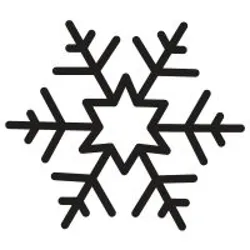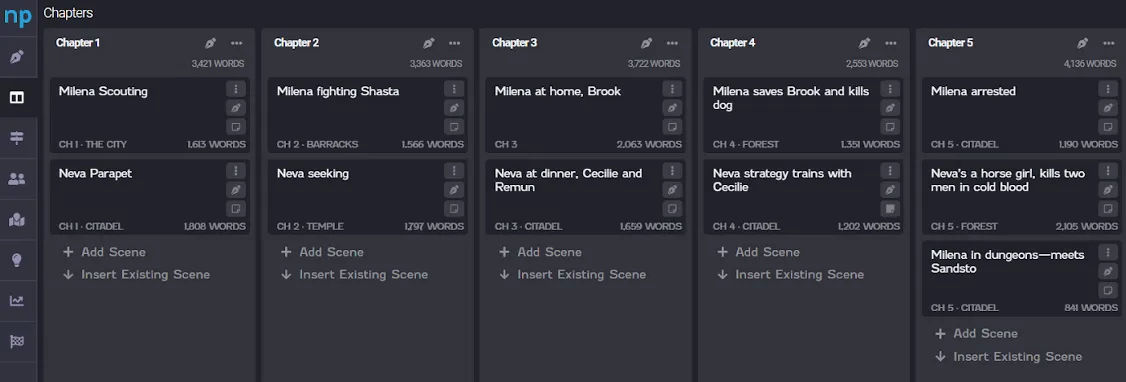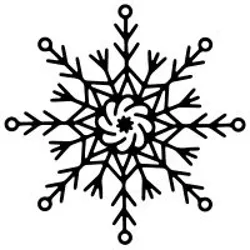How to Use the Snowflake Method to Write Your Novel [STEPS]
Bella Rose Emmorey
book editor, rogue behaviorist, digital marketer, writer, brand builder, plant aunt, and cheese enthusiast.
There are an infinite number of ways to tell a story and an infinite number of ways to create that story. How do you write? Are you organized? Do you love a $ road map$ telling you exactly where you’re going to take the plot and how the characters will change? Or do you prefer wandering out in the dark and finding your way as you go?
There’s no wrong answer! Every writer has a different style and unique preferences, and that rocks. Only you can tell your story the way you’ll tell it.
But if you’d like to try a method that provides a controlled writing process with clear goals and direction, the Snowflake Method might be for you.
Editor's Note: Bella will host a free workshop for developing your novel with the Snowflake Method. $ Sign up for the newsletter$ and $ follow our YouTube channel $ for updates!
What is the Snowflake Method of writing?
The Snowflake Method is a strategy for designing your novel, popularized by Randy Ingermanson. It uses ten steps to build your novel one bit at a time. The metaphor is that you’re starting with a base (triangle shape), and building out until your novel has many individual spires and shapes, like a snowflake. It’s a structured and controllable way to outline and write your novel, so if you love having a firm grip on the reins of your projects, this outlining method might be for you!
Here is a way to visualize the different steps of the snowflake method:

This method starts small and simple with some base elements of a novel, then expands upon those until you’re left with a full first draft.
How does the Snowflake Method for outlining work?
Before you dive into the first draft of your novel, it’s helpful and time efficient to get organized. So open a document, or grab a notebook and pen, and let’s get started with the ten steps for planning your novel using the Snowflake Method.
1. Write a one-sentence summary.
This is a short, snappy hook for your novel. This summary can become your elevator pitch for people who ask what your book is about, and it should be an important element in your book pitch, your press kit, and your marketing materials.

Your one-sentence summary might include your character (a psychic child), the setting (plague-era Europe), the main goal (tracking down her family), and something of the stakes (the harrowing vision coming true).
Take at least an hour to perfect this sentence, because it’s important!
2. Now expand that sentence to a paragraph.
This step will probably take around an hour as well. The paragraph should take us through the setup, major "disasters" of your book, and the ending of the story.
If we reference the classic Three Act structure, your paragraph might look like this:
- Sentence one - background, story setup, introduce the characters
- Sentence two - first disaster, end of Act 1
- Sentence three - second disaster, midpoint of Act 2
- Sentence four - third disaster, end of Act 2
- Sentence five - the end
You’ll only show this paragraph to other people for something like a proposal, because it should spoil the whole story. This paragraph is not teaser text, and it won’t be a blurb on the back of your novel or in your Amazon description—it’s for you and whomever you’re trying to sell your book to.
Now that we have a bird's-eye view of the whole novel, it’s time to zoom in and start developing the finer details.

3. Create character profiles
While you may have completed those first two steps in a couple of days—or a couple of hours—now we’re getting into the nitty gritty, so it’s time to strap in for the long haul. Expect to take at least a week for this segment. In this step, we’re developing our characters’ storylines.
Your characters are the most important element of your novel—you can have next-to-no plot and readers will still be hooked if you’ve created compelling characters who have interesting arcs. It’s good to invest the time upfront to give yourself a strong foundation for the journey each major character will go on.
Randy Ingermanson recommends writing a one-page summary sheet on each of your major characters. What’s on that summary sheet can depend on you, your writing style, and your goals, but here’s a list of elements that you might want to include:
- Character’s name, nicknames
- A one-sentence summary of the character’s storyline, just like we did for the full novel. For example, a character summary for my character Neva from my current WIP might be: “Neva doesn’t want to choose a Bond and take over the nation—good thing she gets lost in a deadly swamp to battle inner and outer demons before she has to decide.”
- The character’s motivation: This is what they want (for Neva, a sense of agency and independence)
- The character’s conflict: What is preventing them from getting what they want (for Neva, lack of confidence and anger management problems)
- The character’s epiphany: What they’ll learn, how they’ll change (for Neva, realizing *spoilers* and finding out that she can take care of things herself)
- A one-paragraph summary of the character’s storyline
Your character sheets don’t have to be perfect on your first go, because you can always come back and edit these documents as the story develops. That’s normal, and honestly preferable! If your characters’ actions don’t change as you get to know them better, you’re probably taking a myopic view of them, which will leave you with a less dynamic and more stagnant result.

NovelPad's character card
4. Expand the paragraph from Step 2 into a page.
It’s time to hone in on the details of that summary paragraph from Step 2. Take each sentence and expand it into its own paragraph. Each paragraph should end in a "disaster," except for the ending.
After this step, you should have a pretty detailed outline of the book! This makes writing quick and easy, and if there are major problems with your story, you should be able to see them now to iron them out before they become a 30,000 word mistake.

5. Write character descriptions.
Write a one-page description for each major character, then half a page for other important characters. These descriptions should tell the story from that particular character’s point of view. This might give you new looks at your characters and story, so keep your other documents close by and make edits as you learn more!
6. Expand the one-page summary from Step 4.
Turn each paragraph of that summary into its own page. This is a great opportunity to lean into the specifics, and to edit for mistakes that you will probably notice by this point.
7. Expand the character descriptions
This is my favorite step—expand each character’s description into a full chart detailing everything you know about the character. Their demographics and technicalities, their likes and interests, allergies, friends, family, background, education, background—everything. Really focus on how the character will change by the end of the novel, and how they’ll end up there. This is a good point in the planning process to edit your previous steps with the new information.
By this step, you might just start writing your novel! You’ve got a solid foundation, and your plot should be all laid out. But if you’d like to keep moving forward solidly and thoroughly, let’s hit the next step.

8. Write your scene list.
The scene list takes an outline to the next level. In this step, you’re literally going to write out every scene in your novel. You can format it however you’d like, but a spreadsheet might make organization easier. Personally, I use $ NovelPad$ because of their chapters page where I can click-and-drag, organize, and label my scenes for an overview of everything:

Or you might just use Google Sheets, and that works too! Whatever method or program you use, making a scene list can simplify your drafting process. You might make a column for each scene and a column to describe what happens in it, then leave it at that. But it could be helpful to get a little more detailed and add columns for things like character POV, location, and other elements that can help you visualize the scene. As you can see in the above screenshot, NovelPad lets you label locations, timestamps, plots, characters, and other elements for each scene quite easily.
9. Write the narrative story description.
This is another optional step, but it’s where you describe each scene. You might briefly describe the conflict, the characters involved and what they’re doing, any setting elements you’d like to include, lines of dialogue that occur to you, etc.
If this isn’t your speed, no worries! Skip right on to Step 10.
10. Write it!
Now it’s time to write your first draft. Since you’ve thoroughly planned it, this should be a breeze. You might find that you’re discovering new things about the story and characters as you write it, and that’s great! A story that develops naturally is often more fun to read, so follow your instincts, and remember to keep your plot and character sheets updated in case you need to reference them for later drafts.

These ten steps can guide you through a controlled and organized process for developing your novel, concept to finished draft. Have you ever tried writing something with this level of planning? Do you prefer to freeball your book with a "discovery draft" instead? Let us know in a comment!
Further reading
Like what you're reading?
Join other authors like you in NovelPad’s free writing community!
Join the communitySimilar Posts
What File Formats are Accepted by Kindle Direct Publishing?
File types for ebooks, paperbacks, and hardbacks on Amazon's KDP.
Ollie Ander
Is probably just a couple cats in a trench-coat—the hair shedding and sunlight napping are highly suspect.
The Writer’s Resolution Guide 2024
Goal ideas and strategies for your new writing year.
Sage Kay
Writer, reader, outfit repeater.
How long is a fantasy book? Words, pages, chapters, scenes, & prologues
What should wordcount goals look like for a fantasy novel?
S.R. Beaston
Crafty with words, wit, and wisdom, just add caffeine to make it more interesting.
30 Literary Elements | How to Use Them + Examples
A nearly comprehensive list of literary elements to try out!
Bella Rose Emmorey
book editor, rogue behaviorist, digital marketer, writer, brand builder, plant aunt, and cheese enthusiast.
What is Write-to-Market? An Author's Fast-Track to Earnings
Writing to market is one of the most successful sale strategies for self-published authors. Here's how.
Bella Rose Emmorey
book editor, rogue behaviorist, digital marketer, writer, brand builder, plant aunt, and cheese enthusiast.
How to Publish on Kindle Unlimited | A Comprehensive Step-by-Step Guide
Everything you need to know about enrolling your book on Amazon's Kindle Unlimited.
Ollie Ander
Is probably just a couple cats in a trench-coat—the hair shedding and sunlight napping are highly suspect.